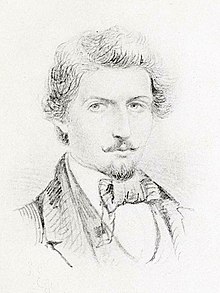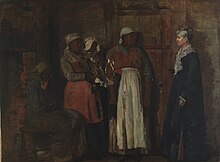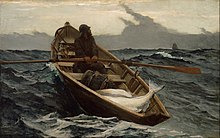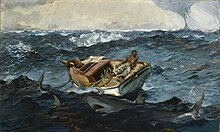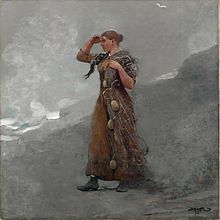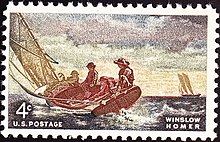Winslow Homer
Homer took on many of her traits, including her quiet, strong-willed, terse, sociable nature, her dry sense of humor, and her artistic talent.
His early works, mostly commercial wood engravings of urban and country social scenes, are characterized by clean outlines, simplified forms, dramatic contrast of light and dark, and lively figure groupings—qualities that remained important throughout his career.
His uncle's Belmont mansion, the 1853 Homer House, was the inspiration for a number of his early illustrations and paintings, including several of his 1860s croquet pictures.
His mother tried to raise family funds to send him to Europe for further study but instead Harper's sent Homer to the front lines of the American Civil War (1861–1865), where he sketched battle scenes and camp life, the quiet moments as well as the chaotic ones.
[13] His initial sketches were of the camp, commanders, and army of the famous Union officer, Major General George B. McClellan, at the banks of the Potomac River in October 1861.
[9] After the American Civil War, Homer turned his attention primarily to scenes of childhood and young women, reflecting nostalgia for simpler times, both his own and the nation as a whole.
[15] Near the beginning of his painting career, the 27-year-old Homer demonstrated a maturity of feeling, depth of perception, and mastery of technique which was immediately recognized.
Though his interest in depicting natural light parallels that of the early impressionists, there is no evidence of direct influence as he was already a plein-air painter in America and had already evolved a personal style which was much closer to Manet than Monet.
"[18] Throughout the 1870s, Homer continued painting mostly rural or idyllic scenes of farm life, children playing, and young adults courting, including Country School (1871) and The Morning Bell (1872).
The same straightforward sensibility which allowed Homer to distill art from these potentially sentimental subjects also yielded the most unaffected views of African American life at the time, as illustrated in Dressing for the Carnival (1877)[21] and A Visit from the Old Mistress (1876).
By that year, Homer had switched his primary Gallery from the Boston-based Doll and Richards to the New York City based Knoedler & Co. Homer became a member of The Tile Club, a group of artists and writers who met frequently to exchange ideas and organize outings for painting, as well as foster the creation of decorative tiles.
[25] As a result of disappointments with women or from some other emotional turmoil, Homer became reclusive in the late 1870s, no longer enjoying urban social life and living instead in Gloucester.
Although he moved away from the spontaneity and bright innocence of the American paintings of the 1860s and 1870s, Homer found a new style and vision which carried his talent into new realms.
[31] In 1883, Homer moved to Prouts Neck, Maine (in Scarborough), and lived at his family's estate in the remodeled carriage house seventy-five feet from the ocean.
[33] In Eight Bells (1886), two sailors carefully take their bearings on deck, calmly appraising their position and by extension, their relationship with the sea; they are confident in their seamanship but respectful of the forces before them.
Other notable paintings among these dramatic struggle-with-nature images are Banks Fisherman, The Gulf Stream, Rum Cay, Mending the Nets, and Searchlight on Harbor Entrance, Santiago de Cuba.
"[32] But despite his critical recognition, Homer's work never achieved the popularity of traditional Salon pictures or of the flattering portraits by John Singer Sargent.
[37] In the winters of 1884–5, Homer ventured to warmer locations in Florida, Cuba, and the Bahamas and did a series of watercolors as part of a commission for Century Magazine.
He replaced the turbulent green storm-tossed sea of Prouts Neck with the sparkling blue skies of the Caribbean and the hardy New Englanders with Black natives, further expanding his watercolor technique, subject matter, and palette.
[39] Children Under a Palm Tree was re-discovered on an episode of Antiques Roadshow in 2008, and was formally attributed to Homer on BBC's television series Fake or Fortune?
Some of his best-known works, A Norther, Key West, The Gulf Stream, Taking on Wet Provisions, and Palms in the Storm, are said to have been produced there.
[41] Homer found inspiration in summer trips to the North Woods Club, near the hamlet of Minerva, New York, in the Adirondack Mountains.
[42] It was on these fishing vacations that he experimented with the watercolor medium, producing works of the utmost vigor and subtlety, hymns to solitude, nature, and to outdoor life.
Another late work, The Gulf Stream (1899), shows a black sailor adrift in a damaged boat, surrounded by sharks as a waterspout approaches.
[45] By 1900, Homer finally reached financial stability, as his paintings fetched good prices from museums and he began to receive rents from real estate properties.
Other late works include sporting scenes such as Right and Left, as well as seascapes absent of human figures, mostly of waves crashing against rocks in varying light.
[49] Homer never taught in a school or privately, as did Thomas Eakins, but his works strongly influenced succeeding generations of American painters for their direct and energetic interpretation of man's stoic relationship to an often neutral and sometimes harsh wilderness.
[54] Perhaps Homer's austere individualism is best captured in his admonition to artists: "Look at nature, work independently, and solve your own problems."
Homer's famous oil painting Breezing Up, now hanging in the National Gallery in Washington DC, was chosen as the image for the design of this issue.
Later, when Winslow Homer spent the years between 1881 and 1882 in the village of Cullercoats, Tyne and Wear, his paintings depicting shores and coastal landscapes changed.
